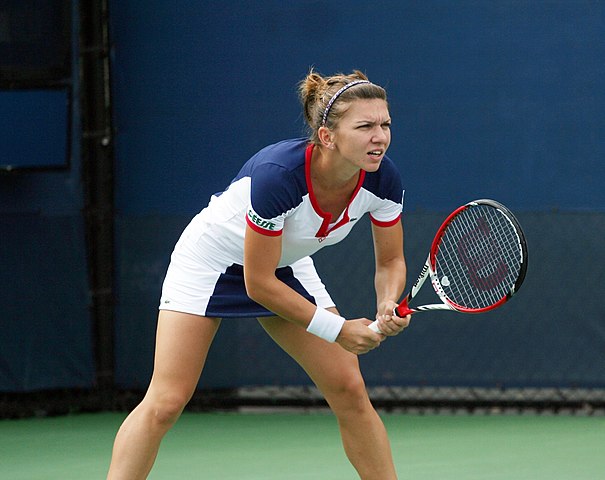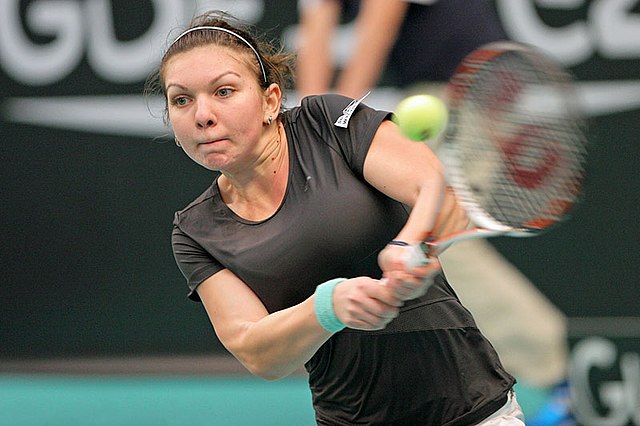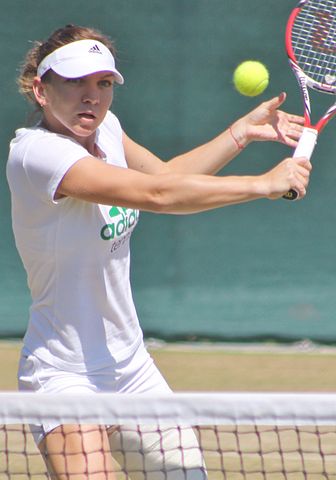
In 2022, I’m counting down the 128 best players of the last century. With luck, we’ll get to #1 in December. Enjoy!
* * *
Simona Halep [ROU]Born: 27 September 1991
Career: 2010-present
Plays: Right-handed (two-handed backhand)
Peak rank: 1 (2017)
Peak Elo rating: 2,178 (1st place, 2015)
Major singles titles: 2
Total singles titles: 23
* * *
Here’s a fun stat to kick us off. In my summaries of Match Charting Project data, I group points into four categories: 1-3 shots, 4-6 shots, 7-9 shots and 10+ shots. 133 women have at least 20 charted matches in the dataset, which covers every active player of note as well as most all-time greats back to Martina Navratilova and Chris Evert.
Only five women have won at least 52% of points in all four of the rally-length categories:
Ashleigh Barty Steffi Graf Simona Halep Justine Henin Iga Swiatek
Serena Williams is below 52% (though still above 50%) in the two longest types of rallies. Evert won less than half of 1-to-3’s, and Navratilova won only 40% of 7-to-9’s. (At least in charted matches, which in their cases are skewed toward finals against each other.)
Our five players don’t have a lot in common, except that they are–by definition–exceptional all-around competitors. Barty and Graf were elite servers whose baseline games were sometimes underrated because their serves were so good. Henin was great at everything. Halep and Swiatek are top-drawer baseliners who have gotten the most out of their serves.
In 2014, Louisa Thomas wrote of Simona at Grantland, “She is a defensive aggressor, an aggressive defender. She is becoming unclassifiable.” At that stage in her career, she wasn’t yet winning so many of the 1-to-3’s. Her serve, and the game she would construct around it, were works in progress. Even then, the “clay-court grinder” tag didn’t quite suffice. Halep’s career has been a remarkable story of steady improvement, and she is even more difficult to classify now than she was eight years ago.
* * *
When Simona Halep first tried her hand at the adult tour, the “clay-court grinder” label was a best-case scenario. She won the French Open girls’ title in 2008 and ascended to number one in the junior rankings, but she was hardly a slam-dunk prospect. A WTA staffer who profiled the 18-year-old in August of 2010 sounded more excited about Alexandra Dulgheru than Halep.
It’s easy to see why the pundits were slow to anoint Simona a future star. In 2012, the 20-year-old was a circuit veteran, but one who struggled to win half her matches. Her third tour-level final came on the dirt at Brussels that year, after she upset both Jelena Janković and Dominika Cibulková. She put up a good fight in the title match against Agnieszka Radwańska, but Aga finished her off with a bagel.

Her serve was simply not good enough. She won fewer than 53% of her serve points that year, a tick down from the 54% marks she posted in 2010 and 2011. Radwańska won nearly two-thirds of Halep’s own first serve points in the Brussels final. At Linz later in the year, Victoria Azarenka used Simona’s deliveries as batting practice, winning 66% of return points.
After parts of three years on tour, Halep had won fewer than half of her main-draw matches, and even on clay, she barely broke even. She was only five-feet, six-inches tall, so there was little reason to expect she would develop a bigger game. She finished the 2012 season ranked 47th on the WTA computer, good enough to rank fourth best among 21-and-unders. But it took a hefty bit of wishcasting to see her following in the footsteps of Petra Kvitová and Caroline Wozniacki, top-tenners who were only one year older.
Simona had four more months of frustrating grinding to go before everything changed.
* * *
2013 began as 2012 ended. Halep won about half of her matches, rarely stringing two victories together, and losing lopsided contests against the players she would need to draw even with. She lost 6-3, 6-1 to Radwańska in Auckland, then dropped back-to-back matches to Sloane Stephens–who was higher ranked despite being 18 months younger–at Hobart and the Australian Open.
Simona hobbled into Rome after two early-round losses on clay. Her ranking down to 64th in the world, she breezed through the qualifying draw, then battered her way past a roster of experienced WTA stars. She started with a 6-1, 6-1 dismantling of Svetlana Kuznetsova, then won a three-setter against 4th-seeded Radwańska–her first win against the Polish star in four tries. Halep overcame Roberta Vinci in front of the Italian’s home crowd, and then came back from another one-set deficit to beat Jelena Janković in the quarter-finals.
The breakthrough week didn’t translate into success at the majors–she would lose to Carla Suárez Navarro in the Roland Garros first round and Li Na in the second at Wimbledon–but Halep kept the momentum going everywhere else. After the French Open, she won back-to-back titles at Nuremberg and ‘s-Hertogenbosch–the latter on grass.

By the end of the year, she had added titles in Budapest, New Haven (with wins against Wozniacki and Kvitová), and Moscow. She finished the season with an undefeated run at the Tournament of Champions in Sofia, where she beat Ana Ivanović and Samantha Stosur.
In the six months between Rome and Sofia, Halep went from a clay-court specialist on the margins of the tour to a rising star just outside the top ten. She leapfrogged Stephens to finish the year as the highest-ranked player younger than 23. The Radwańska win seemed to have cleared a mental block. After the first time they played–when Aga won, 6-1, 6-2–Halep thought, “I cannot beat her ever.” She proved herself wrong, and she went on to beat nearly everyone else as well.
* * *
Simona wouldn’t hire her first big-name coach until 2014, when she teamed up with Wim Fissette. The 2013 breakthrough came with the Romanian coach Adrian Marcu. Halep credited her step forward to a more relaxed attitude on court, the sort of platitude that we often hear–and players might even believe–but tells us nothing.
Halep’s stats improved across the board, including five-percentage-point jumps from 2012 in both serve and return points won. With data from the Match Charting Project, we can see that she became considerably more aggressive in rallies in her fourth season on tour. The Aggression Score metric quantifies how often players hit point-ending shots (for good or bad), and scales the result to a number between about 100 (very aggressive) and -100 (very passive).
In the handful of charted matches from 2012, Halep’s Aggression Score in rallies was -57. Wozniacki and Radwańska were often more passive than that, but few other successful players are. In 2013, Simona’s Aggression Score in rallies increased to -22. That’s still below average, but it represents far more risk-taking than the 2012 mark.
Once forgettable, now (occasionally) fearsome:
The Halep serve in 2022
With Fissette, Halep began to work on her serve in earnest. Her first-strike numbers would improve, but as far as rally aggression is concerned, she never advanced beyond the appetite for risk that she showed in 2013. Her Aggression Score stayed roughly the same (-24) in 2014, and has steadily headed back downward since. In 2015, it dropped to -36; in 2017 it fell to -47; and in 2019 it returned to the starting point of -57.
It turned out that Simona could win with a more passive style, but only once her serve improved. The degree to which the five-foot, six-inch Romanian developed that part of her game is one of the more remarkable parts of her story.
* * *
About a year ago, a friend pointed out that Maria Sakkari was doing something very special. Every season from 2016 to 2021, she improved her first-serve winning percentage. Over the whole span, she gained more than ten percentage points, from 58.6%–worse than 86% of WTA players–to 69.9%–better than 93%. She didn’t quite maintain that level throughout the 2021 season, but she still improved on her 2020 campaign, and her 2022 numbers so far are even better.
Few players have done anything remotely similar to Sakkari’s recent run. You will not be surprised to learn that Simona Halep is one of them.
Simona didn’t take steady, incremental steps like Sakkari did. In 2012, she won 56.4% of first serve points, a number so low that it is barely sustainable for a tour-level player. Two years later, with the help of Wim Fissette, she won over 66.4% of first serve points, a rate better than three quarters of her peers. Only nine other players in the last decade-plus have done anything like that:
Player Weak 1st% %ile Strong 1st% %ile K Bertens 2015 59.5% 18 2019 71.9% 97 M Sakkari 2016 58.6% 13 2021 69.9% 93 D Kasatkina 2017 59.0% 15 2021 66.4% 78 S Halep 2012 56.4% 3 2014 66.4% 78 Y Shvedova 2011 59.4% 17 2016 66.1% 75 A Cornet 2011 58.9% 14 2020 66.1% 75 M Linette 2016 59.9% 21 2020 65.8% 73 Y Wickmayer 2012 60.0% 22 2017 65.8% 72 A Sasnovich 2016 58.4% 11 2018 65.1% 67 S Stephens 2011 59.7% 19 2015 65.0% 66
The “%ile” columns show how each first-serve winning percentage stacks up against the WTA tour as a whole. Halep’s 66.4% in 2014 isn’t as good as a couple other of these remarkable late developers, but her starting point was far worse than any of them. And of this elite group, only Aliaksandra Sasnovich bettered her numbers so quickly.
Halep didn’t quite maintain that 66% first-serve winning percentage, but the numbers she posted in 2015 and beyond were much closer to her career high than her previous lows. She never fell below 62.7% for a full season, and her rate has exceeded 65% since 2020. She may have even reached a new level this year, at age 30. In 19 matches in 2022, her first-serve percentage sits at a career best of 68.4%, a number that ranks her between much taller sluggers such as Aryna Sabalenka and Clara Tauson.
* * *
The knock on Halep has always been that she couldn’t close. She reached her first major final at the 2014 French Open, but lost a heartbreaker to Maria Sharapova. She reached the same stage in 2017, where she was the heavy favorite against Jeļena Ostapenko. She won the first set, but collapsed at 3-all in the decider. Her third major final was another three-set loss, this one at the 2018 Australian Open to Wozniacki.
Another strike against her reputation: In 2017, she lost multiple matches–including the 2017 Roland Garros final–when she had the chance to secure the number one ranking. She finally cleared the hurdle in October and held on the top spot for a total of 64 weeks, but it’s hard not to think of the opportunities she missed to amass an even more impressive record.
You might remember the 2018 Wimbledon third-rounder against Hsieh Su-Wei, when Halep lost from match point up. Six times, she was two points away from the win. Or perhaps her loss to Kiki Bertens in the 2018 Cincinnati final comes to mind, another instance when she was one point from victory. Or maybe you just think of the embarrassing on-court coaching visits when she simply berated herself (“I’m ridiculous bad”) before listlessly seeing out a loss.
It’s certainly true that Simona could’ve used a mental coach earlier in her career. An interviewer in 2010 asked her to describe herself in one word, and she went with “nervous.” Even when she finally hired a sports psychologist, her coach at the time, Darren Cahill, suspected she wasn’t committed to the process. A different mindset would’ve done wonders, and it probably would’ve nudged her quite a bit higher on the all-time list.
Still, it’s possible to take this line of criticism too far. Halep lost her first three major finals, but then she became the only player to lose so many and still go on to win one. Halep missed several chances to become number one … and then she did it, and she played well while she held the position. She’s lost a few matches she should’ve won, but the Hsieh and Bertens matches are two of only three times since her breakthrough that she failed to win when she held match point.
* * *
Once she convinced herself she deserved major titles and the spot at the top of the rankings, Halep was able to turn in one of the most impressive performances of the last decade.
At Wimbledon in 2019–on Simona’s weakest surface–the draw opened up for everyone. Second seed Naomi Osaka lost in the first round, and top seed Ashleigh Barty lost in the fourth round. Halep beat Victoria Azarenka and teen sensation Coco Gauff early on, and she cruised to the semi-final without facing a seeded player. She made quick work of Elina Svitolina in the semis to earn a date with Serena Williams in the final.
This time, the pressure was off. Serena was the one with history on the line, as she targeted her 24th major title. The two women had played ten times before, and Williams had won nine. The one time that Halep beat her, at the 2014 WTA Finals in Singapore, Serena bounced back to get her revenge only four days later.
No one expected Halep to win. Simona has never been shy about expressing her admiration for her opponent that day, and one suspects that she would’ve been fine to see Serena make history instead.
Instead, the Romanian played the match of her life. Williams never had a chance to get settled, and Halep refused to let her into the match. Simona recorded 14 winners against only 3 unforced errors, and she saved the one break point she faced. It was over, 6-2, 6-2, in only 56 minutes, the most lopsided major final loss in Serena’s long career.
* * *
Halep struggled for the rest of 2019, but she came back strong in 2020 and remained effective even after the six-month break for Covid-19. She recovered to number two in the rankings, and she stayed in the top three until an injury finally knocked her out of the top ten in the middle of last year.
Now age 30, Simona can only go as far as her health will allow her. Her Wikipedia page uses some form of the word “injury” 28 times, and she has missed a handful of tournaments after a thigh tear last month. The odds are against a return to the very top, but she’s preparing for her comeback with Patrick Mouratoglou, Serena’s former coach. After a strong start to 2022 in Australia, she clearly believes she has more great tennis ahead of her.
She remains unclassifiable. Her serve has developed into a weapon as her baseline game has drifted back toward more cautious counterpunching. The New Yorker called her “no one’s idea of a grass court player,” and she hoisted a Wimbledon trophy. Known as something of a choker, she has ascended to the highest peaks of the sport.
Just ten years ago, most people in the tennis world didn’t think Halep would amount to much. But careers don’t have to make sense. “Aggressive baseliner,” “defensive aggressor,” or “aggressive defender,” Simona has helped define an era in which few women have been able to stay close to the top for as long as she has.
* * *
Subscribe to the blog to receive each new post by email: